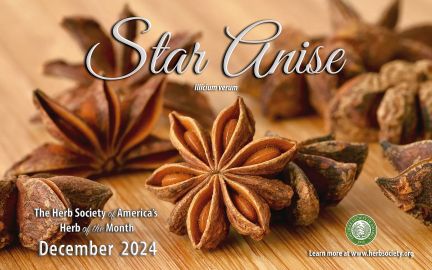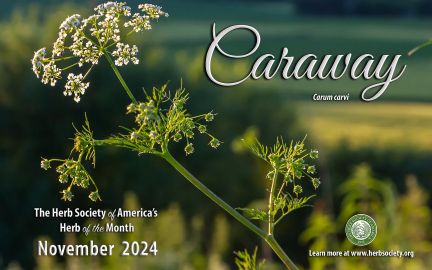Herb Society of America
Hill Country UnitHerb of the Month Archives
February
Mullein (Verbascum thapsus).
-
Versatile, fuzzy mullein is a gardener’s friend, an herbalist’s delight and an engineering marvel, all on it’s own.
-
A member of the snapdragon family, mullein has flowers that are flat and open, unlike the irregular “dragon faces” of snapdragons.
-
Mullein oil is extracted from the leaves and flowers and is used for many ailments; often used with other extracts.
-
Some of the chemicals are: glycosides, which has an anti-inflammatory effect, saponina, which has an expectorant effect, and polysaccharides, which have a demulcent, for coughs and throat irritation..
December
Star Anise (Illicium)
-
The eight-pointed seed pod from an evergreen tree native to Southwest China and Vietnam, is the spice known as star anise. This small evergreen tree is in the magnolia family, Schisandraceae.
-
Star anise flowers are yellow and from a little distance look similar to narcissus.
-
Star anise has been used in China for flavoring and medicine for over three thousand years.
-
The “seeds” are actually half of the caraway fruit, which splits down the middle and strongly resembles cumin seeds. They have a distinctive fragrance when crushed.
-
The seed pods are harvested before ripening (green) and sun-dried, resulting in the rich brown color.
-
Both the seeds and the pods contain the flavor and are finely ground together. When used in recipes whole, they should be removed before serving.
-
Star anise is one of the five spices in the blend, Chinese five-spice.
-
In Japan, the bark of the star anise tree has been used to make incense.
-
The deep licorice-like aroma has subtle sweet and herbal notes. The flavor is used in sweet, spicy and savory dishes, including baked goods, chilled desserts, sauces, beverages and even red meats.
-
The liquors absinthe, Sambuca, and pastis all have infused star anise flavoring.
-
Though the flavor is similar, it is not related to anise seed. However, both plants have anethole, a compound responsible for the anise flavor in both seeds.
-
Historical medicinal uses included Chinese herbalists using star anise as a stimulant, an expectorant and to treat indigestion to European healers using it in teas for rheumatism and chewing the seed for indigestion.
-
Though there is now a synthetic way to manufacture it, star anise contains shikimic acid which is one of the primary components of the influenza-fighting drug Tamiflu.
-
Research continues on extracts from star anise, including testing antifungals and antimicrobial compounds.
-
According to Chinese folklore, finding a star anise with more than eight points was considered good luck. Star anise was also considered protection against the “evil eye”.
-
While similar to Illicium verum, the seeds of Japanese star anise, Illicium anisatum are quite toxic.
November
Caraway (Carum carvi)
- Caraway is a biennial and related to dill, cumin, fennel and anise which also produce aromatic fruits, commonly called seeds.
- The caraway plant is 18-24″ tall with delicate, white to pink, umbel-shaped flowers and finely dissected, feathery leaves. It flowers in the spring of the second year of growth.
- The common name seems to come from the Arabic name for the seed karawya, but the etymology is unclear. It has had many different names in different languages, including in Latin, Greek, Sanskrit and Arabic.
- The seeds are actually half of the caraway fruit, which splits down the middle and strongly resembles cumin seeds. They have a distinctive fragrance when crushed.
- Caraway has been used for 5000 years, dating back to the Mesolithic era. It was used in the burial of ancient Egyptians. Early Greek and Roman used it in cooking and for medicinal purposes.
- Turmeric is used fresh or can be frozen and is prepared by slicing, chopping, or grating.
- Caraway has been used historically to aid digestive disorders and was added to breads, cakes and baked fruit in the Middle Ages for that purpose.
- Love potions included caraway as the ingredient that kept couples faithful and was given to homing pigeons to encourage their return home as well.
- Caraway flavors sausage, sauerkraut, soups and stews, cheeses, breads, cakes and cooked fruit.
- Seeds coated with sugar are used for comfits and to decorate cakes and cookies.
- Kümmel is a caraway-flavored liqueur. Caraway oil also flavors aquavit, gin, and schnapps.
- Caraway oil also is used commercially in mouthwashes, toothpaste, chewing gums and is used in perfumery.
- Caraway seeds are best harvested in the early morning when the fragile seed heads are moist with dew. This prevents the seeds from shattering before they are collected. The seed heads are thrashed after a drying process.
October
Turmeric (Curcuma longa)
- Turmeric has a nutty flavor with a slightly bitter edge.
- Turmeric is a warm spice that combines well with chicken, fish, eggs, curry, chutney, marinades, rice, and pickles.
- Turmeric is excellent in juices, tea and smoothies.
- Add turmeric to soups, stews, and sauces for both color and flavor.
- Add to vegetables prior to roasting or sauteing.
- Turmeric is used fresh or can be frozen and is prepared by slicing, chopping, or grating.
- Add turmeric blends well with other herbs in compound butters.
- Turmeric can be eaten raw or cooked.
- Once ground, turmeric begins to lose flavor. Store in a dark place and replace when flavor diminishes.
- Use the side of a spoon to scrape the skin off fresh turmeric roots.
- Be careful with cutting the fresh root as it will stain anything it touches yellow.




